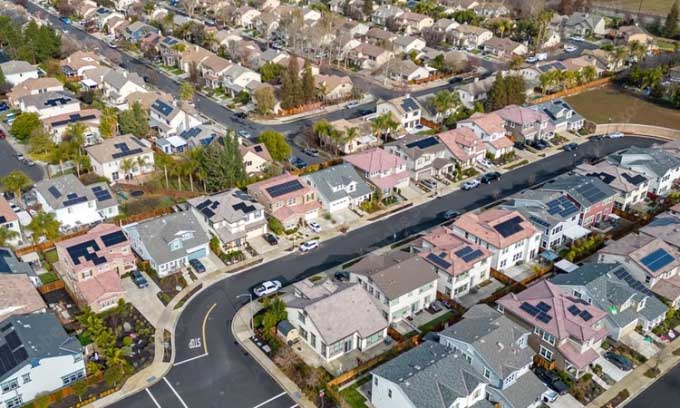As electricity prices turn negative due to a surge in rooftop solar energy production, the government of California is grappling with how to manage the excess electricity.
In sunny California, solar panels are everywhere. They dot the arid desert landscape of the Central Valley and are scattered across rooftops in downtown Los Angeles. According to the latest estimates, California has nearly 47 gigawatts of installed solar capacity, enough to power 13.9 million homes and account for over a quarter of the state’s electricity supply. However, the state government and grid operators are currently facing a peculiar situation. Too much solar energy on sunny days, when demand is not particularly high, is leading to negative electricity prices, as reported by the Washington Post.

Homes covered with solar panels in California. (Photo: Adobe)
In response, California has ceased encouraging rooftop solar installations and slowed down the installation pace. However, the diminishing economic incentives could hinder the growth of solar energy in a state striving to transition to renewable energy. As other states build more solar power plants, they may soon encounter similar issues.
“This is an insurmountable challenge,” said Michelle Davis, global director of solar research at the energy research and consulting firm Wood Mackenzie Power and Renewables. “But it is a challenge that many grid operators have never had to address.”
Solar energy offers many remarkable benefits: it incurs almost no operating costs after installation, produces no air pollution, and generates power without burning fossil fuels. However, a key drawback is that the sun does not shine all the time.
More than 15 years ago, a research team at the National Renewable Energy Laboratory modeled future solar energy deployment and uncovered a peculiar phenomenon. As the amount of solar energy in the grid increases, the difference between electricity demand and renewable energy follows a U-shape. High demand in the morning is replaced by nearly zero demand at noon, when solar energy can meet all the electricity needs. Then, as the sun sets, demand spikes again.
The California grid operator, CAISO, refers to this effect as the “duck curve.” The effect is most pronounced in the spring months when solar panels receive abundant sunlight but there is little demand for heating and cooling. In recent years in California, the duck curve has morphed into a massive trough, leading to wasted solar energy. In 2022, the state wasted 2.4 million megawatt-hours of electricity, 95% of which was solar power. Last year, the state experienced that level of waste within just the first eight months.
Clyde Loutan, director of renewable energy integration at CAISO, stated that California has long prepared for increased solar energy in the grid, but they underestimated the rapid growth of residential solar installations.
Reducing solar energy generation is not technically challenging, according to Paul Denholm, a researcher at the National Renewable Energy Laboratory. However, curtailing self-generated electricity raises electricity prices while diminishing the benefits of installing rooftop solar. Since the 1990s, California has compensated rooftop solar owners when they feed energy back into the grid. This means they earn $0.20 to $0.30 for each kilowatt-hour of electricity produced.
But a year ago, the state government changed this system and currently only compensates new solar owners based on the value of their electricity to the grid. In the spring, when the duck curve is at its deepest, the compensation can drop to nearly zero. Customers can earn more if they install panels and provide electricity to the grid in the morning or evening. This change has faced fierce opposition from Californians and rooftop solar companies. Wood Mackenzie predicts that residential solar installations in California will decrease by about 40% in 2024.
Other states that have been slower to adopt solar energy than California are also beginning to experience similar situations. Nevada, which generates 23% of its electricity from solar power, has also recorded a deepening duck curve. Hawaii, where thousands of homes have rooftop solar panels, has reduced payments for those households.
California grid operators hope their experience will provide lessons for other states. CAISO is selling excess electricity to several neighboring states. California also plans to install more batteries and other solar energy storage systems for use in the evening. Upgraded transmission lines may also help distribute electricity more evenly. Some power outages stem from areas lacking sufficient transmission lines to meet sudden spikes in solar energy.


















































